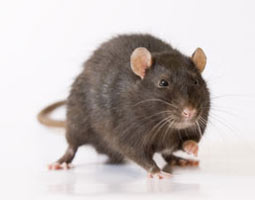|
|
RAT & MOUSE
REMOVAL
Identification
 The
house mouse is
a small, slender rodent that has a slightly pointed nose, small black,
somewhat protruding eyes, large sparsely haired ears, and a nearly
hairless tail with obvious scale rings. They are generally grayish
brown with a gray or buff belly. An adult house mouse weighs about 2/5
to 4/5 of an ounce (11 to 22 grams). House mice breeds year round.
Females come into heat and are capable of conceiving every four days. A
female may have 5 to 10 litters of 4 to 8 young per year. The gestation
period is 18 to 21 days. A female is sexually mature at 6 to 10 weeks
of age. The average house mouse lives for one to two years. The
house mouse is
a small, slender rodent that has a slightly pointed nose, small black,
somewhat protruding eyes, large sparsely haired ears, and a nearly
hairless tail with obvious scale rings. They are generally grayish
brown with a gray or buff belly. An adult house mouse weighs about 2/5
to 4/5 of an ounce (11 to 22 grams). House mice breeds year round.
Females come into heat and are capable of conceiving every four days. A
female may have 5 to 10 litters of 4 to 8 young per year. The gestation
period is 18 to 21 days. A female is sexually mature at 6 to 10 weeks
of age. The average house mouse lives for one to two years.
 The Norway rat is a
stocky burrowing rodent also called a sewer rat, brown rat, barn rat,
gray rat. An adult weight about 1 pound. Their fur is coarse and
usually brownish or reddish grey. A female may come into heat
every 4 to 5 days and have a litter of 6 to 12 young. The gestation
period is 21 to 23 days. A female is sexually mature at 3 months of
age. The average female has 4 to 6 litters a year. The Norway rat is a
stocky burrowing rodent also called a sewer rat, brown rat, barn rat,
gray rat. An adult weight about 1 pound. Their fur is coarse and
usually brownish or reddish grey. A female may come into heat
every 4 to 5 days and have a litter of 6 to 12 young. The gestation
period is 21 to 23 days. A female is sexually mature at 3 months of
age. The average female has 4 to 6 litters a year.
Damage
In homes and commercial buildings they may feed on various stored food
items or pet foods. They usually contaminate foodstuffs with urine,
droppings, and hair. One mouse can excrete up to 100 fecal pellets and
a rat can excrete 50 droppings per day, as well as deposit hundreds of
small droplets of urine during its travels. Damage to
insulation
inside walls and attics quickly occurs when rodents reach high
populations in homes, apartments, offices, and commercial buildings.
Rodents often make homes in large appliances, such as dishwashers,
refrigerators, stoves, and washers and dryers. They may gnaw electrical
wiring, and create fire hazards. They further damage the structure by
gnawing openings through doors, windows sills, walls, ceilings and
floors.
Rodent
Signs
A client will usually complain of squeaks and fighting noises, clawing
and scrambling in the walls, or gnawing sounds will be heard. You will
hear the sounds mostly at night unless the infestation is real
bad. You will see rat or mouse droppings or you will notice a
musky odor that identifies their presence. You will see outdoor run
ways along walls and buildings. You will see outside burrows free of
dirt, next to the foundation.
Excluding
Rodents
Nuisance Bat and Wildlife control does rodent proofing on buildings, we will
seal all holes the diameter of a pencil or larger. We
rodent-proofing with heavy materials that will resist rodent gnawing,
such as concrete, galvanized sheet metal, and heavy gauge galvanized
steel hardware cloth. Large holes may need to be filled with concrete,
smaller holes can be stuffed with copper wool or filled with
caulk. We will screen all vents and vent pipes with
1/4
inch hardware cloth. Seal gaps around windows and doors with
weather-stripping. Install sweeps on doors to close gaps at the bottom.
Metal kick plates will prevent rodents from gnawing on doors. We seal
gaps around pipes and wires that enter the building Cap or screen
drains in basement floors so rodents cannot enter through them.
Trapping
Trapping is the most effective method of controlling mice and rats. It
requires labor and time. Nuisance Bat and Wildlife Control
doesn’t have a
mouse trapping program, we leave this up to the homeowner, we will
mouse proof the structure though. We do provide a rat
trapping
program along with the structure exclusion.
|

